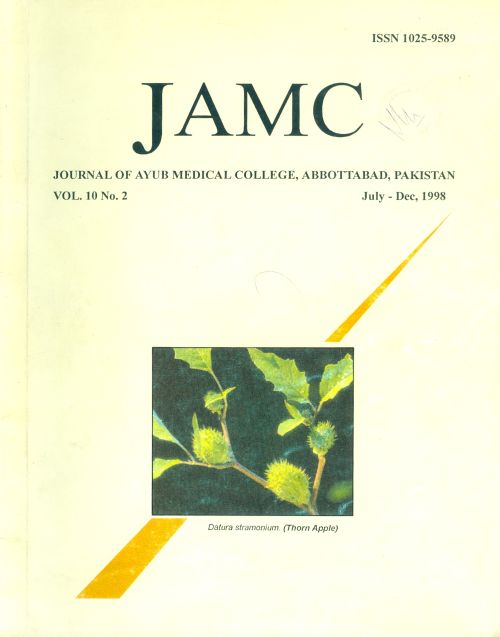MANAGEMENT OF TRACHEO BRONCHIAL FOREIGN BODIES IN CHILDREN
Abstract
This is a study of 32 cases of foreign body tracheobronchial tree in children, spread over two years’ period.More than 65 % of patients were of two years and below. The male to female ratio was 2:1. More than 70% of foreignbodies were vegetable in nature. Foreign bodies were located more often in the right main bronchus as compared tothe left (3:2). In all cases, foreign bodies were removed under G.A., with the help of rigid pediatric bronchoscopes.There was no mortality. In 04 cases no history of foreign body inhalation was forthcoming and bronchoscopy wasdone because the child had persistent cough and episodes of dysphonia. There was a delay of 1-10 days beforepresentation in the majority of patients. Majority of the patients presented 24 •hours after the inhalation of foreignbody. Removal of foreign body tracheobronchial tree through rigid bronchoscope under GA is a safe and lifesavingprocedure with good results.References
Cunanan, DS. The flexible fibreoptic bronchoscope in the
body removal: Experience in 3()0 cases. Chest; 1978;73
(Suppl),724-726.
Hollinger, PH and Hollinger LD. Use of the open tube
bronchoscope in the extraction of foreign bodies. Chest:
:73 (Suppl), 721- 724.
Rothman BF and Beckman. Foreign bodies in the larynx and
tracheobronchial tree in children. Otolaryngology,
:8915:434-436.
Avtac et al: inhalation of foreign bodies in children, report of
cases. J. Thorac. Cardiovac. Surg; 1977.74/1; 145-151.
Issue
Section
License
Journal of Ayub Medical College, Abbottabad is an OPEN ACCESS JOURNAL which means that all content is FREELY available without charge to all users whether registered with the journal or not. The work published by J Ayub Med Coll Abbottabad is licensed and distributed under the creative commons License CC BY ND Attribution-NoDerivs. Material printed in this journal is OPEN to access, and are FREE for use in academic and research work with proper citation. J Ayub Med Coll Abbottabad accepts only original material for publication with the understanding that except for abstracts, no part of the data has been published or will be submitted for publication elsewhere before appearing in J Ayub Med Coll Abbottabad. The Editorial Board of J Ayub Med Coll Abbottabad makes every effort to ensure the accuracy and authenticity of material printed in J Ayub Med Coll Abbottabad. However, conclusions and statements expressed are views of the authors and do not reflect the opinion/policy of J Ayub Med Coll Abbottabad or the Editorial Board.
USERS are allowed to read, download, copy, distribute, print, search, or link to the full texts of the articles, or use them for any other lawful purpose, without asking prior permission from the publisher or the author. This is in accordance with the BOAI definition of open access.
AUTHORS retain the rights of free downloading/unlimited e-print of full text and sharing/disseminating the article without any restriction, by any means including twitter, scholarly collaboration networks such as ResearchGate, Academia.eu, and social media sites such as Twitter, LinkedIn, Google Scholar and any other professional or academic networking site.









